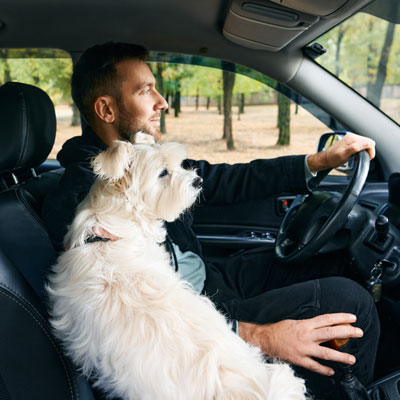Last Updated on 11 months by Dr Alisha Barnes

For many pet owners, a car ride with your dog is a routine but essential part of pet ownership. Maybe you’re heading to the vet, the dog park, or just out for a family adventure. Regardless, the experience is not always a pleasant one – especially if your pup experiences anxiety. Understanding and addressing your dog’s nervousness during car rides is not just about the immediate, vocal reactions; it’s about ensuring their long-term mental and physical well-being.
To help guide you through this, we turned to Dr. Alisha Barnes, a renowned pet chiropractor local to the Fort Collins and Broomfield, CO area. Here’s how you can make every dog’s car ride better, from the start of the adventure to a calm arrival at your destination.
Understanding Dog Anxiety on the Move
Before we can tackle the problem, we must understand it. Dr. Barnes is keen to share that dog anxiety in the car can stem from various sources, including past negative experiences, discomfort from motion sickness, fear of unknown situations like car sounds and turbulence, and even picking up on their owner’s anxiety. This angst may be expressed through whining, barking, drooling, shaking, or even more severe symptoms like urinating or vomiting.
Identifying the Symptoms
The first step in addressing your dog’s travel anxiety is recognizing when they’re feeling it. Dogs can’t communicate their discomfort in words, so it’s up to you to observe their behavior. Dr. Barnes recommends watching for these common signs of anxiety:
- Pacing or inability to settle
- Excessive drooling
- Panting
- Yawning out of context
- Restlessness
- Seeking an escape
- Trembling
By identifying these symptoms, you can help your dog work through their unease.
Preparing Your Pup for the Ride
A bit of preparation goes a long way in easing your dog into a more comfortable traveling experience.
Gradual Acclimation to the Car
Dr. Barnes suggests getting your dog used to the car in safe, non-anxiety-inducing ways. Start by simply sitting in the parked car with treats and toys to create positive associations. Slowly increase the time spent in the car before moving on to short, non-destination car rides that don’t end at the dreaded vet’s office or groomer’s.
Familiarize with the Travel Crate or Seat Belt
Whether you use a crate or a safety seat belt designed for dogs, acclimate your pup to it well before the first road trip. Dr. Barnes emphasizes praising and treating your dog for spending time in their special car transport gear to make it a comforting rather than confining experience.
Strategies for a Calm Car Trip
Once your dog is more comfortable with the idea of getting into a car, it’s time to ensure the trip itself doesn’t trigger anxiety.
Set the Scene
Create a calming environment in the car. Play soothing music or use pheromone sprays designed to reduce stress. Adjust the temperature and ensure good airflow. Dr. Barnes advocates for minimizing the number of unknown factors that might spook your pet, such as having a favorite stuffed animal onboard.
Regular Breaks and Movement
If the ride is long, stop periodically for short walks and bathroom breaks. This not only addresses physical needs but also allows your dog to mentally reset. Dr. Barnes encourages these breaks to involve some time outside of the car, even if it’s just around a rest stop.
The Role of Pet Chiropractic Care
Dr. Barnes offers a holistic approach to pet health, citing chiropractic care as a modality that can alleviate anxiety. Chiropractic adjustments can help with spinal health that, in turn, supports the nervous system, potentially reducing the general level of stress your pup experiences. Alongside this, it’s important to maintain a healthy diet, regular exercise, and a safe ‘home base’ environment for your dog.
Putting It All Together for a Better Ride
In summary, the key to easing your dog’s car anxiety is a patient and practiced approach. Begin with understanding the root cause of their fears, carefully preparing them for the car, implementing strategies for a calmer ride, considering holistic wellness care, and, above all, being empathetic.
Remember, reducing your dog’s anxiety during car trips is not an overnight fix, but with persistence, you can turn their next travel experience from a nervous one to a happy tail-wagging adventure. Dr. Barnes and I both encourage you to start implementing these tips with love and patience next time you’re ready to hit the road with your four-legged friend. Happy travels!
